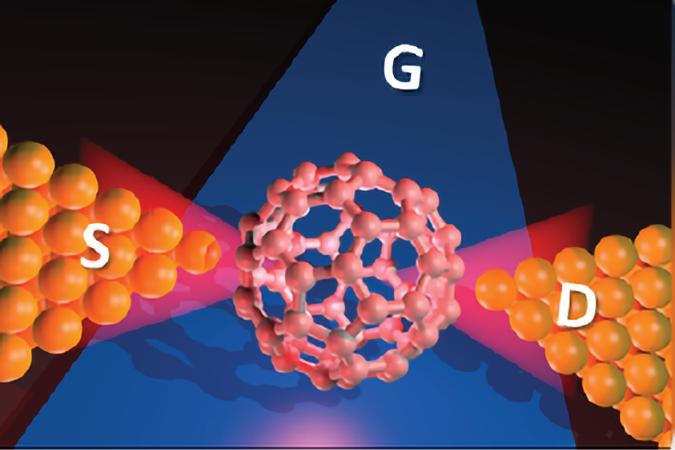Terahertz spectroscopy enters the single-molecule regime

This is an illustration of a Single molecule transistor (SMT) with a bowtie antenna structure. S, D, and G denote the source, drain, and gate electrodes of the SMT, respectively. A single molecule is captured in the created nanogap. Credit: 2018 Kazuhiko Hirakawa, Institute of Industrial Science, The University of Tokyo
However, one lesser-used form of light is the terahertz (THz) region. Lying on the electromagnetic spectrum between infrared and microwaves, THz radiation does have the right frequency (around 10^12 Hz) to excite molecular vibrations.
Unfortunately, its long wavelength (hundreds of micrometers) is around 100,000 times a typical molecular size, making it impossible to focus THz beams onto a single molecule by conventional optics. Only large ensembles of molecules can be studied.
Recently, a team led by The University of Tokyo's Institute of Industrial Science (IIS) found a way around this problem. In a study in Nature Photonics, they showed that THz radiation can indeed detect the motion of individual molecules, overcoming the classical diffraction limit for focusing light beams. In fact, the method was sensitive enough to measure the tunneling of a single electron.
The IIS team showcased a nanoscale design known as a single-molecule transistor. Two adjacent metal electrodes, the source and the drain of the transistor, are placed on a thin silicon wafer in a “bowtie” shape. Then, single molecules–in this case C60, aka fullerene–are deposited in the sub-nanometer gaps between the source and drain. The electrodes act as antennas to tightly focus the THz beam onto the isolated fullerenes.
“The fullerenes absorb the focused THz radiation, making them oscillate around their center-of-mass,” explains study first-author Shaoqing Du. “The ultrafast molecular oscillation raises the electric current in the transistor, on top of its inherent conductivity.”
Although this current change is minuscule–on the order of femto-amps (fA)–it can be precisely measured with the same electrodes used to trap the molecules. In this way, two vibrational peaks at around 0.5 and 1 THz were plotted.
In fact, the measurement is sensitive enough to measure a slight splitting of the absorption peaks, caused by adding or subtracting only one electron. When C60 oscillates on a metal surface, its vibrational quantum (vibron) can be absorbed by an electron in the metal electrode.
Thus stimulated, the electron tunnels into the C60 molecule. The resulting negatively charged C60? molecule vibrates at a slightly lower frequency than neutral C60, thus absorbing a different frequency of THz radiation.
Apart from providing a glimpse of tunneling, the study demonstrates a practical method to obtain electronic and vibronic information on molecules that only weakly absorb THz photons. This could open up the wider use of THz spectroscopy, an under-developed method that is complementary to visible-light and X-ray spectroscopy, and highly relevant to nanoelectronics and quantum computing.
###
The article, “Terahertz dynamics of electron-vibron coupling in single molecules with tunable electrostatic potential,” was published in Nature Photonics at DOI: 10.1038/s41566-018-0241-1.
About Institute of Industrial Science (IIS), the University of Tokyo
Institute of Industrial Science (IIS), the University of Tokyo is one of the largest university-attached research institutes in Japan.
More than 120 research laboratories, each headed by a faculty member, comprise IIS, with more than 1,000 members including approximately 300 staff and 700 students actively engaged in education and research. Our activities cover almost all the areas of engineering disciplines. Since its foundation in 1949, IIS has worked to bridge the huge gaps that exist between academic disciplines and real-world applications.
Media Contact
All latest news from the category: Physics and Astronomy
This area deals with the fundamental laws and building blocks of nature and how they interact, the properties and the behavior of matter, and research into space and time and their structures.
innovations-report provides in-depth reports and articles on subjects such as astrophysics, laser technologies, nuclear, quantum, particle and solid-state physics, nanotechnologies, planetary research and findings (Mars, Venus) and developments related to the Hubble Telescope.
Newest articles

A new puzzle piece for string theory research
Dr. Ksenia Fedosova from the Cluster of Excellence Mathematics Münster, along with an international research team, has proven a conjecture in string theory that physicists had proposed regarding certain equations….

Climate change can cause stress in herring larvae
The occurrence of multiple stressors undermines the acclimatisation strategies of juvenile herring: If larvae are exposed to several stress factors at the same time, their ability to respond to these…

Making high-yielding rice affordable and sustainable
Plant biologists show how two genes work together to trigger embryo formation in rice. Rice is a staple food crop for more than half the world’s population, but most farmers…



